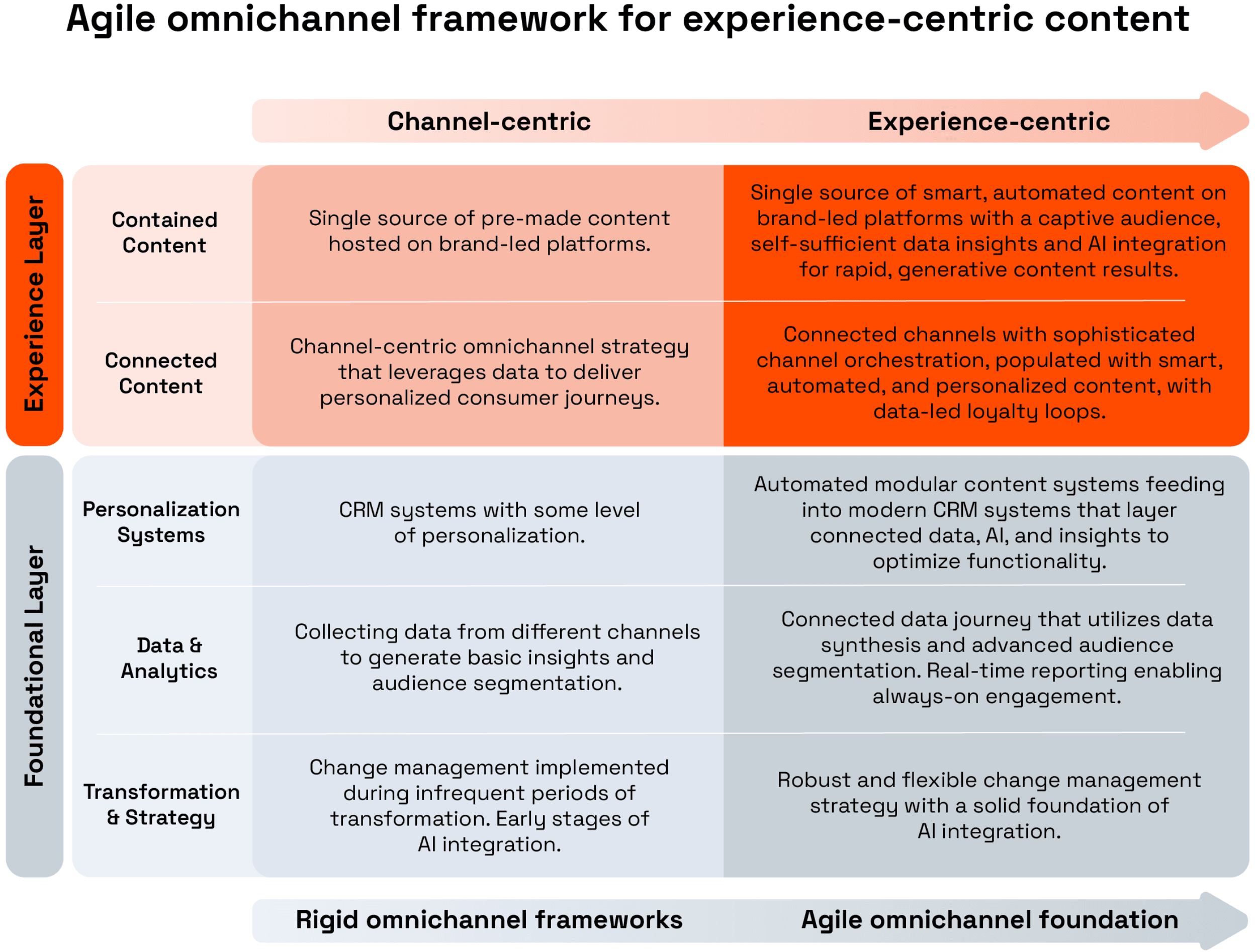
Agile Omnichannel Transformation: Reaching HCPs in a Tech-Driven Era
October 27, 2025
Generative AI is rapidly evolving the way that practitioners and patients receive content and information about pharmaceuticals. Already, almost 1 in 3 HCPs say they frequently use AI-based tools for information about treatment, whilst 69% patients have used ChatGPT or other AI tools for treatment research. With a new, rapid and convenient source of information at play, not only is generative AI is shifting the way that patients and HCPs engage with each other, but critically it can divert attention and engagement away from the content that pharmaceutical brands provide.
In this tech-driven era, pharmaceutical brands need to rethink their HCP engagement strategies. Rigid omnichannel production models that are channel-centric no longer hold the same engagement effectiveness as they once did. They must be adapted to compete with AI-integrated content, evolving from channel-centric to experience-centric. An experience-centric engagement strategy builds a hyper-targeted omnichannel journey around the individual HCP, harnessing the power of AI and automation to generate rapid, engaging content, with campaign performance that can be reviewed and updated in real-time.
But it’s not just AI’s engagement diversion that’s a challenge; the pharmaceutical industry itself is shifting. From the early research phase all the way to landing in the market, the rise of generative AI technology and automation is accelerating the rate at which the industry can operate. Clinical-trials alone could see “a 12-plus month acceleration in the time it takes to conduct a trial” as well as significant cost reductions, with new technology streamlining processes. This acceleration has a knock-on effect on how rapidly brands need to produce commercial content that communicates, connects, and engages with HCPs. Meanwhile, generative AI tools are churning out content that is more immediate and in different formats that gain more attention, requiring brands to level up their own content production. Not only does content need to be more engaging to compete with the speed of AI, but the underlying foundation that supports content production needs to keep up with the pace of the industry.
During this era of rapid acceleration "organizational agility” will be “a differentiator” for the pharma market. Brands with an ability to adapt quickly to evolving technologies will be better equipped to deal with the volatile landscape of rapid transformation that AI incites. When it comes to content production, pharmaceutical brands require an agile omnichannel foundation that combines strategy and transformation, analytics and data, and personalization systems, to keep up with the speed of AI and minimize disruption. This agile foundation will enable pharmaceutical brands to transform the external HCP experience, from channel-centric to experience-centric, disrupting the way that medical content is consumed by practitioners.

Beyond omnichannel
Omnichannel, in its current state, is not delivering enough HCP engagement for most pharmaceutical companies. “Only 28% of HCPs believe pharma´s customer engagement strategies meet their needs” demonstrating an urgent need to rethink the omnichannel approach. But digital and physical touchpoints are not going anywhere, and brands have to find a way to make each touchpoint work together to generate effective, holistic engagement across the entire omnichannel landscape. So, how do brands transform beyond omnichannel, to an experience-centric content strategy that actually meets HCP needs?
When we talk about moving towards an experience-centric content strategy, this requires a huge shift in efficiency and effectiveness across the whole omnichannel spectrum. Aside from the content production process itself, the key foundational layers of transformation & strategy, data & analytics, and personalized systems must be optimized.

From AI integration and change management to data insights and modular content, each of these three functions within the Foundational Layer feed into and strengthen each other. When executed correctly, these functions provide a fortified and flexible foundational layer, supporting the production of smart, effective content, that paves the way for the experience layer above.
The Experience Layer is where the internal optimization transforms the HCP experience. Pharmaceutical brands can elevate their contained content strategies with a self-sufficient owned-platform ecosystem. Meanwhile the enhanced content connected strategy allows brands to elevate the experience across every channel, ultimately creating a loyalty loop. This loyalty loop evolves at each stage of the HCP’s experience, generating a continuous journey of engagement. It fosters loyalty and advocacy from a connected experience that engages right from the first piece of content they receive in the consideration phase, all the way through to the loyalty phase where exclusive, personalized content is received based on their interactions within the connected ecosystem.

Building an agile foundation
As established in the executive summary, AI is not only affecting communications on the patient-level, but the operational landscape as well. Though AI has been a part of the pharmaceutical industry for many years, since its introduction into the mainstream in 2023 the technology’s usage, and its sophistication, has increased. This accelerated AI development is expected to continue with the global artificial intelligence market projected to reach $4.8 trillion by 2033 – a huge 25-fold increase from 2023.
Brands in all industries need to be prepared for the shifting technology landscape, but being such a complex and heavily regulated industry, pharma requires a more robust risk strategy. Pharmaceutical brands need an agile omnichannel foundation that is adaptable to on-coming tech evolutions and lays down the groundwork for better omnichannel engagement strategies.

Transformation & Strategy
From AI integration to change management, in order to start moving the needle from channel-centric to experience-centric content engagement strategies, pharmaceutical companies require a significant transformation. And leadership is recognizing that. According to McKinsey, around 90% of all organizations are already undergoing some form of digital transformation, demonstrating the scale of evolution happening across the corporate world.
However, whilst many pharmaceutical senior leaders may be aware of the technological transformations required to remain competitive, there is currently a huge implementation gap between early adoption and maximum value add. A 2024 survey reports that, while 32% are taking steps to scale AI technology, only 5% of life science organizations have deployed Gen AI as “a competitive differentiator”, according to pharmaceutical and medtech leaders surveyed.
A huge part of the AI integration outlook is dependent on AI-literacy. A barrier to integration may be AI itself, how it is viewed, what its function is, what it replaces, and what it ultimately affects within the business. Senior leaders need to assess how, and in what ways, AI will make an impact to their business, and how they are going to address the gap of AI-literacy within their companies.
Integrating AI is not as simple as adding in a tool to the content production workflow. For example, a key challenge is understanding where AI will fit into teams and its role in co-creation of assets. Relying too heavily on AI tools and neglecting the human element could lead to inauthentic content, whilst reluctance to integrate a higher level of AI platforms could prevent the evolution needed to produce personalized content at speed.
A clear change management strategy that takes into consideration data, roles, workflows, leadership and governance, is required to avoid falling into common AI integration pitfalls. AI tools and capabilities are changing so rapidly that a transformation cannot take years anymore. Strategy must be flexible to accommodate for accelerated evolution.
Some examples of this strategy include:

It’s not just AI and technology that pharmaceutical brands should be wary of implementing to ensure their omnichannel strategy is impactful enough to engage HCPs. All elements that factor into omnichannel engagement, from hiring the right talent to having a streamlined legal and compliance system in place, need to be considered and implemented to prepare for change and ultimately maximize transformation ROI and deliver value for the business.

Analytics & data services
One of the most important tools all pharmaceutical brands must have in their toolbox is high-quality data. Data is the power behind AI automated content production and the key to producing personalized, targeted content strategies.
However, data management itself is a huge roadblock for many brands with 72% of industry professionals seeing data and analysis as a big challenge in relation to their HCP engagement activities. Multiple touchpoints offer data collection opportunities but integrating them into as a standard, omnichannel approach takes time. In addition, understanding what to do with that data and having the right platform to synchronize data in a useable and effective way is essential to being agile.
Data collection
In an omnichannel landscape, opportunities for data collection can come from a medley of different touchpoints, with HCP-facing content playing a large role in maximizing engagement and data input. According to an EPG Health report only 25% of industry professionals agree that data is comprehensively collated, demonstrating a huge opportunity for improvement within this fundamental building block. Pharmaceutical brands should have a two-step approach to creating a foundational data collection layer:
Step 1: Connecting the data journey
Having the right touchpoints at every level of omnichannel engagement is a crucial step in creating an agile foundation, allowing pharmaceutical brands to bridge the gap between online and offline in their data analysis. It might seem like an obvious point, but it’s imperative that brands maximize these touchpoints at every opportunity. By connecting the channels and breaking down data siloes, brands will be able to create a single source of truth, enabling contained data loops, real-time reporting, and synchronized engagement.
Connected online touchpoints should map out engagement across entire online journeys, from data collected within CRM systems to webinars and online portals. Meanwhile, face to face and online to offline events are hotspot opportunities for data capture. Interactive touchpoints, such as apps, digital screens, QR codes, and sign-up forms at events should be merged with online platforms to create complete journeys. Seamless, connected journeys will allow pharmaceutical brands to stack opportunities for connection that generate more engagement over time and build stronger HCP relationships.
Step 2: Data touchpoint engagement
Once the data touchpoints are aligned, brands should focus on incentivizing first-party data engagement. Pharmaceutical brands must take a value-add approach to their omnichannel touchpoints to engage HCPs and encourage them to input data at every opportunity. Whatever the touchpoint, content should be produced to provide additional value for the HCPs, whilst the data that is collected should be harnessed to create a more personalized experience.
A value-add approach to content could include:

Data synchronization
HCP data should be collated and synchronized between platforms to create insights that lead to better engagement strategies across every touchpoint. With a clear data synchronization strategy, enabled by AI, pharmaceutical brands will be able to adapt to new data touchpoints, developing more complex journeys, and obtaining richer insights. Data insights and loyalty loop strategies lay down the foundation for greater data analysis and personalized engagement outcomes, paving the way for more effective and engaging content strategies.
Advanced consumer insights
With the right technology at their fingertips, pharmaceutical brands are now able to create more in-depth consumer profiling than ever before. Using data integration systems to combine structured and unstructured data from different touchpoints, combined predictive modelling, pharmaceutical companies can create a more holistic picture of HCPs within a single customer view.
AI-powered audience segmentation can generate real-time updates and a holistic view of audience metrics using a combination of real-world and synthesized data. This hyper-targeting can also help identify key HCPs to target, allowing pharmaceutical companies to utilize their resources more efficiently and effectively. This richer insight into target HCPs allows pharmaceutical brands to create more effective, personalized content that better resonates with their audience.
Using AI to reinforce data analysis will have an impact on the effectiveness of pharma engagement strategies across the entire spectrum of communication activities. Not only within campaign management and digital profiles, but for any customer-facing engagement that requires rapid content delivery. For example, McKinsey predicts that using gen AI tools ‘to provide on-demand retrieval, summarization, and synthesis of both unstructured data… and structured information’ will have a potential impact of 10-15% improved effectiveness and productivity of field teams, aiding more targeted conversions with HCPs. Setting the right data system will have a huge impact across almost all engagement areas, allowing for rapid content that arrives in the hands of pharma marketers and sales reps when they need it most.

Personalization systems
With advanced data synchronization and AI-enabled analytics unlocked, pharmaceutical brands can advance into the third layer of the agile omnichannel foundation: personalization. By unlocking optimized personalization systems, more advanced and automated strategies, such as modular content and modern CRM systems, can be implemented. These advanced personalization systems are key building blocks in ultimately forming the experience-centric engagement strategies require to effectively target HCPs.
Modular medical content
Personalization is a non-negotiable for pharmaceutical brands. Gone are the days that content can be a one-size fits all for HCPs who have different specialties, different requirements, and different preferences. Luckily, with automated tools such as Figma, pharmaceutical brands can unlock modular content production processes. Taking key visuals, copy, and brand elements from a single asset, multiple pieces of content can be instantly scaled across different sizes, formats, and purposes. From a compliance point of view, pharmaceutical brands can upload pre-approved copy into the system to develop rapid responses to content requirements. This speeds up the approval process, whilst ensuring content is regulated and compliant.
Data & analytics is intrinsically linked to the performance of personalized content. The impact of the modular content created is dependent on the quality of the data collected, and how that data has been analyzed and reported. To ensure the modular content is hyper-targeted to HCP preferences, pharmaceutical brands must connect their personalized content to their optimized in-depth insights.
Modern CRM strategies
Once the modular content layer is added to the toolbox, pharmaceutical brands can look to integrate an advanced CRM strategy. This should include a modular categorizing system that focuses on different needs, such as dividing up medial sales from marketing, HCP engagement etc. Pharmaceutical brands can then use modular content to rapidly update and populate engagement platforms with personalized content.
By layering connected data, AI and analytics, and experience tools a modern CRM system can provide better functionality for pharmaceutical sales and marketing users, making content production and publication more intuitive and effective.

Transforming the HCP experience
Even when developed in siloes, strategy & transformation, data & analytics, and personalization systems, can all deliver some level of improved engagement to HCPs. However, to evolve beyond omnichannel, pharmaceutical brands must break down those siloes and ensure these elements work together to provide an experience-centric content experience.
Whilst 75% of industry professionals agree that the overall effectiveness of their HCP engagement activities are satisfactory or above, a low rate of only 18% consider them to be high or very high. Additionally, when compared to the 28% of HCPs satisfied with pharma engagement strategies, this demonstrates a disconnect between the satisfaction of current strategies and their ability to deliver results. With a strong agile omnichannel foundation in place, pharmaceutical brands can combine the 3 functions together to create strong, holistic content engagement strategies that address these low HCP engagement rates.

Connected experiences
When it comes to creating an effective HCP engagement strategy, pharmaceutical brands should be evolving from interacting with HCPs on a fragmented journey to nurturing relationships with their target audience across the entire content experience. Individual channels must be integrated into a connected omnichannel content strategy that combines traditional in-person channels with strategic media buys, modern CRM systems, and a combination of physical and digital touchpoints. Whilst many pharmaceutical companies are already implementing some level of a connected experience, there are several key points across the content journey where pharmaceutical brands need to elevate their strategy and deliver a connected experience.
Channel orchestration
The key to a successful content ecosystem is having all the channels and content work holistically together, creating an intelligent ecosystem that nurtures HCPs well beyond the individual experience itself. Only 15% of industry professionals would consider their HCP engagement channel integration to be fully omnichannel, with fully integrated channels, personalization, seamless journeys, centralized content, and data management. All the layers of strategy & transformation, data & analytics, and personalization systems must be centralized and work seamlessly for brands to achieve this.
This where the transformation strategy in particular comes in as an essential stage of the production ecosystem. It’s these initial stages of content planning, where pharmaceutical brands must have an understanding what omnichannel channels are available to them, their purpose within the omnichannel strategy, and how they can be optimized to deliver insights.
Delivering an integrated, personalized experience
Data and insights should be paired with personalization systems to ensure that the channel orchestration is effective in providing a bespoke experience that engages HCPs no matter where their consumer journey begins.
With the right data management system in place and AI optimization taking on the heavy lift in pulling data from across larger databases, pharmaceutical brands can unlock real-time synchronization and reporting. By adapting data systems to update in real time, brands can trigger smart content engagement strategies that are automated to generate instant engagement optimization.
With a connected strategy in place for both digital and physical channels, data loops that generate key metrics will help to evolve future campaigns. That is why identifying key content touchpoints is critical: it will impact not only one campaign or launch, but optimize future initiatives, as the campaign metrics feedback into future insights. This loyalty loop keeps HCPs coming back for the experience that they have come to expect.
With a connected content framework, pharmaceutical brands can then begin to build in integrated experiences into the omnichannel system. For example, an engagement strategy that we’re already seeing in the pharmaceutical market is building gamified content strategies that, when combined with educational materials, provide real value for HCPs. VR/AR elements can be added in to elevate the experience, whilst AI-led adaptive gamification can provide an ultra-personalized experience where the gamified experience is based on the behaviors and skill. Personalizing these experiences using data and analytics can enhance the value provided by pharmaceutical companies to the HCPs and deliver a more engaging overall experience.

Contained Experiences
In APAC, 52% of physicians “ranked a single source of content”, and 45% ranked “on-demand information” as top improvement areas for pharmaceutical companies. This demonstrates a desire for closed content spaces that unlock more convenient methods of research and communication. In addition to externally hosted connected experiences, pharmaceutical brands should consider developing AI-led content ecosystems that enable brands to create a closed source of rapid, automated content.
Owned digital platforms, such as websites, webinars, CRM systems for data-driven newsletters, and bespoke apps, provide an opportunity to deliver immersive content experiences with entire online worlds that fully submerge their audience within the site’s content. These owned channels allow pharmaceutical brands to have more authority over their content and provided tailored materials that educate and inform about their products.
For example, Pfizer created the PfizerPro platform, consolidating multiple resources across websites, microsites, webinars, case studies, sample ordering, for HCPs in a single omnichannel portal accessible via web and mobile app. Although this platform is a great example of a closed content source, the experience could be improved with more advanced tagging systems, generative AI integration that provides rapid content, and internal data tracking and analysis that provides fast, accurate results. To achieve this within their own content ecosystems, pharmaceutical brands require bespoke AI systems that learn on internal data to create better network of information and quicker, more accurate results.
Not only do owned channels provide an exceptional experience, but these digital touchpoints can play a key role in data collection. These metrics can be leveraged to generate retargeted campaign that nurture HCPs along every step of their experience with the brand. By marrying together owned and closed channels, production expertise with strategic media buying, and data analysis with intelligent content, pharmaceutical brands can deliver an immersive engagement strategy.

The holistic experience
We’re not seeing the evolution of AI winding down anytime soon. And with HCPs and patients already adopting the use of generative AI in their own research, pharmaceutical brands need to act now to integrate, rather than compete, with the technology. Pharmaceutical brands should be moving beyond omnichannel, from channel-centric to experience-centric to compete in this tech-driven era and transform their content strategies into holistic connected and contained content.
What this whitepaper has outlined is a huge transformational lift for pharmaceutical brands, into an agile omnichannel foundation. Whilst we know that not all brands are at a stage where they can pull all the levers to unlock this shift, there are some tactics that can be implemented now, and some incrementally over time, to move the needle towards experience-centric content.
By creating an ‘experience-centric’ engagement strategy the production process itself becomes more efficient, producing more valuable data, automating increasingly targeted content, and ultimately generating more effective HCP strategies. Engaging HCPs through a strategy that’s both more effective and efficient paves the way for more sales, stronger loyalty, and deeper affinity for the pharmaceutical brands.
At the end of the day, what’s going to create real value for pharmaceutical companies is creating an HCP experience that delivers impact. Experiences themselves are holistic and require different systems and channels to work together in order to create them. Therefore, pharmaceutical brands should lead with an experience mindset that naturally breaks down internal foundational siloes to produce the most engaging experience. Each pharmaceutical brand has its own unique toolkit of resources and systems available to them, which will dictate the balance they can strike between preparing for transformation and delivering right now. But with a clear focus on an agile omnichannel foundation, each step towards an experience-centric outcome will begin to evolve and future-proof HCP engagement.
Loading...